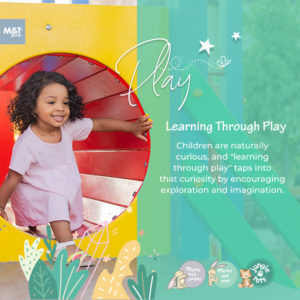With their newfound ability to walk and constantly improving language skills, your 1-year-old is developing at a staggering rate. Between 12 months and 2 years, kids are starting to do things on their own, seeing cause and effect, and actively engaging with others in their environment.
Parental involvement is essential to a 1-year-old’s development. Indeed, parents stimulating them, interacting with them, teaching them things, and exposing them to age-appropriate challenges and experiences encourages exploration and interaction.
But there’s no need to pull out a mountain of toys with all the bells and whistles; simple activities work just as well. I can sit down with a child with one block and come up with 100 different activities because it’s all about being playful and interacting with them.
Not sure where to start? We rounded up several fun learning activities for 1-year-olds at home.
1. Make Music
Make music using percussion instruments like rattles, spoons, pots and pans, bells, cymbals, and drums. Find fun tunes to play that have a rousing beat. Play along with her as well as encouraging her to play by herself.
Skills learned: Coordination, listening skills, and musical exploration
2. Play House
Create a fort from a cardboard box, play tunnel, or playhouse. Include an entrance and an exit, and encourage your child to go in and out. (You might need to show him at first.) Boost the entertainment factor with some pretend play, like knocking on the door or ringing the doorbell, and asking if anyone is home.
Skills learned: Social skills, gross motor skills, and exploring their environment
3. Phone a Friend
Hand a phone to your child and keep one for yourself. Pretend to make calls, and hold conversations with each other or imaginary people. Use funny voices, and create silly characters on the other line. Some play telephones also allow you to record your and your child’s voices and play them back, which can enhance the fun.
Skills learned: Language and social development
4. Use Water and Sand
Once your child reaches 18 months, fill a large tub with water or sand, and give him free rein to dig, pour, scoop, and more. When you’re playing with them, talk and sing along, encourage them to copy what you’re doing, and then try to copy what they’re doing. (Never leave your child unattended around water). This fun activity for 1-year-olds is especially helpful for the development of fine motor skills.
Skills learned: Creative play, fine motor skills, tactile stimulation, and social development
5. Talk Through a Tube
Talk through a cardboard tube, and see how your baby responds to the change in your normal speaking voice. Let her take a turn to see what sounds she can make. Kids this age love to play with language, and this activity gives them an opportunity to practice new and novel sounds. Language is really about imitating sounds. Babbling turns into real words, which turns into a sense of humor.
Skills learned: Auditory discrimination, turn-taking
6. Fetch Objects
Send your child on different “errands” around the house, asking him to get his shoes, bring you the ball, or find his cup. Besides practicing receptive language skills by following directions, this learning activity for 1-year-olds creates a sense of independence and accomplishment.
Skills learned: Understanding directions, memory skills
7. Walk on Contact Paper
Looking for sensory activities for 1 year olds? Cut a piece of clear contact paper at least two feet long. Remove the backing and tape the contact paper, sticky side up, to the floor or carpeting. Then let your child have fun running, jumping, dancing, or just standing on the paper while wiggling their toes on the sticky surface. This is a fresh approach to learning about bodies. Very often, we as parents think we have to have rules for games and do things in order. Sticky paper is just a fun free-for-all. Parents can also put small toys on the sticky surface and let toddlers try to pick them up.
Skills learned: Sensory awareness, muscle strength, body awareness
8. Change Her Reflection
Put a dot of red lipstick on your toddler’s face, and distract her for a few minutes before putting her in front of a mirror. If your child reacts to her image by touching her nose or trying to wipe off the mark, it indicates she realizes there’s something out of the ordinary in her reflection. “Very young children don’t have a sense of self, but at this age it’s clear to them who they are when they look in the mirror,” Dr. Leiderman says. But don’t worry if she doesn’t react yet—she will soon!
Skills learned: Self-awareness and identity
9. Count Fingers and Toes
Toddlers love to count their fingers and toes, so show your little one how to touch each digit only once as you count out loud. Kids counting in order is not important. Just like you’re giving them new words, numbers are part of life. Use them in context to count toes or objects, so they can eventually learn the concepts of numbers.
For different variations of this learning activity for 1-year-olds, count the stairs as you go up and down, count while you’re waiting for the light to turn green, and count the bubbles floating in the air.
Skills learned: Basic number skills, one-on-one correspondence skills
10. Write on Crumbs
Spread rice cereal or crumbled crackers on a cookie sheet, and show your 1-year-old how to “write” in the crumbs with his fingers. This gives children the opportunity to imitate the adults and older siblings in their lives, which is a major meaningful activity of early childhood.
Skills learned: Early handwriting skills, understanding cause and effect
11. Crawl Through Tunnels
Divide puzzle pieces or parts of a toy set into two piles, placing a pile at either end of a play tunnel so your child has to “commute” back and forth through the tunnel to complete his task.
Skills learned: Sustained attention, sensory processing, learning how to complete multi-step sequences





